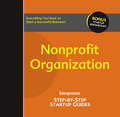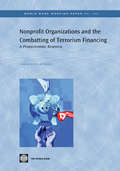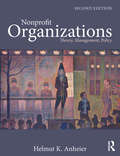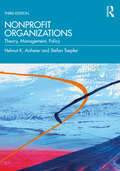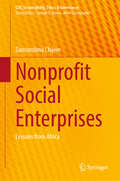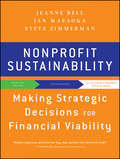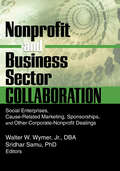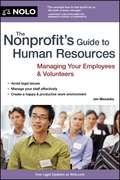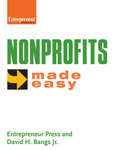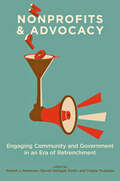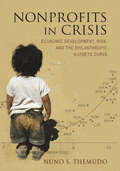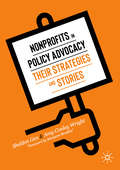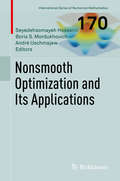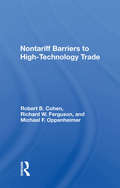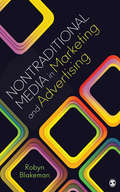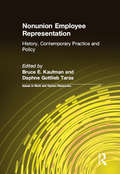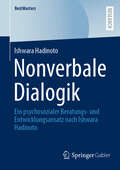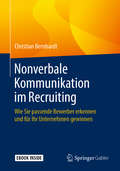- Table View
- List View
Nonprofit Organization
by Inc The Staff of Entrepreneur MediaThe experts at Entrepreneur provide a two-part guide to success. First, learn how to turn your desire for change into a successful-and satisfying-nonprofit organization. Then, master the fundamentals of business startup including defining your business structure, funding, staffing and more.This kit includes: Essential industry-specific startup essentials including industry trends, best practices, important resources, possible pitfalls, marketing musts, and more Entrepreneur Editors' Start Your Own Business, a guide to starting any business and surviving the first three years Interviews and advice from successful entrepreneurs in the industry Worksheets, brainstorming sections, and checklists Entrepreneur's Startup Resource Kit (downloadable)More about Entrepreneur's Startup Resource KitEvery small business is unique. Therefore, it's essential to have tools that are customizable depending on your business's needs. That's why with Entrepreneur is also offering you access to our Startup Resource Kit. Get instant access to thousands of business letters, sales letters, sample documents and more - all at your fingertips!You'll find the following: The Small Business Legal Toolkit Sample Business Letters Sample Sales Letters
Nonprofit Organizations
by Robert S. Kaplan David P. NortonNonprofit organizations strive to deliver mission outcomes, not superior financial performance. So even more than for-profit companies, these organizations need a comprehensive system of nonfinancial and financial measures to motivate and evaluate their performance. This chapter examines the strategy maps of the Boston Lyric Opera and Teach for America.
Nonprofit Organizations and the Combatting of Terrorism Financing
by Emile van der Does de WilleboisOne of the ways in which terrorist organisations raise and transfer funds, is by using non-profit organisations (NPOs). Ever since the adoption of the Special Recommendation VIII on the abuse of NPOs for Terrorism Financing purposes by the FATF in 2001, countries have struggled to find a proper way to address this potential terrorism financing risk. In many important ways however, the work of NPOs deal with the conditions conducive to the spread of terrorism, so it is essential that in trying to address one aspect of the terrorist threat - terrorism financing- we do not inadvertently diminish the impact of other ways of tackling the issue. This article argues that in discussing the threat and how to address it, policy-makers need to be specific, not tainting the whole sector with the same brush. Virtually all governments already interact with the NPO sector and those avenues should be used for dealing with this issue- it is inefficient and ultimately counterproductive to devise an entirely new regulatory framework. The ultimate objective is to enhance the transparency of the sector- the people in charge of NPOs, their sources of funds and particularly the way those funds are spent. That aim serves a much wider purpose than just countering terrorism financing and touches on many aspects of civil society good governance that the sector itself and others have been debating for a long time. When devising public policy on this issue the contribution of the NPO sector to fighting terrorism be recognized and used to its full advantage. Moreover the sector's own stake in being "clean" and being so regarded by others should be acknowledged, thus making them an indispensable partner in drawing up such policies. For the same reason, self-regulation should be considered.
Nonprofit Organizations: Theory, Management, Policy
by Helmut K. AnheierIn this new edition of his popular textbook, Nonprofit Organizations: Theory, Management, Policy, Helmut K. Anheier has fully updated, revised and expanded his comprehensive introduction to this field. The text takes on an international and comparative dimensions perspective, detailing the background and concepts behind these organizations and examining relevant theories and central issues. Anheier covers the full range of nonprofit organizations – service providers, membership organizations, foundations, community groups – in different fields, such as arts and culture, social services and education. He introduces central terms such as philanthropy, charity, community, social entrepreneurship, social investment, public good and civil society, whilst explaining how the field spills over from public management, through nonprofit management and public administration. The previous edition won the Best Book Award at the American Academy of Management in 2006. Nonprofit Organizations: Theory, Management, Policy is an ideal resource for students on undergraduate and postgraduate courses in both Europe and North America.
Nonprofit Organizations: Theory, Management, Policy
by Helmut K. Anheier Stefan ToeplerIn this new edition of the popular textbook, Nonprofit Organizations: Theory, Management, Policy, Helmut K. Anheier and Stefan Toepler have fully updated, revised, and expanded this comprehensive introduction to a growing field. The text takes on an international and comparative perspective, detailing the background and concepts and examining relevant theories and central issues. Anheier and Toepler cover the full range of nonprofit organizations—service providers, membership organizations, foundations, community groups—in different fields, such as arts and culture, health and social services, and education. Introducing central terms such as philanthropy, charity, social entrepreneurship, social investment, and civil society, they explain how the field relates to public management and administration. This textbook is systematic in its approach to theories, management, and policy. The first edition won the Best Book Award at the American Academy of Management in 2006, and this new edition will continue to match the growing demand for academic teaching. Nonprofit Organizations: Theory, Management, Policy is an ideal resource for students of both undergraduate and postgraduate courses.
Nonprofit Social Enterprises: Lessons from Africa (CSR, Sustainability, Ethics & Governance)
by Zamumtima ChijereThe practice and the concept of social enterprise has been studied extensively across the globe; however, the flourishing of nonprofit social enterprises has received little attention over the years, especially in Africa. This book provides a framework to help indigenous nonprofit social enterprises flourish. A flourishing organization is one that can sustain organizational operations in an environment in which employees find pleasant and fulfilling. The results and recommendations provide in this book come from a theoretically grounded quality study that identifies the factors influencing an organization. Featuring data from eight indigenous nonprofit social enterprises in Africa, this book is useful to students, scholars and practitioners in entrepreneurship, human resource management, nonprofit management, and organizational behavior.
Nonprofit Sustainability
by Jan Masaoka Steve Zimmerman Jeanne BellPraise for NONPROFIT SUSTAINABILITY"This is much more than a financial how-to book. It's a nonprofit's guide to empowerment. It demystifies mission impact and financial viability using The Matrix Map to provide strategic options for any organization. A must-read for every nonprofit CEO, CFO, and board member."--Julia A. McClendon, chief executive officer, YWCA Elgin, Illinois"This book should stay within easy reaching distance and end up completely dog-eared because it walks the reader through a practical but sometimes revelatory process of choosing the right mix of programs for mission impact and financial sustainability. Its use is a practice in which every nonprofit should engage its board once a year."--Ruth McCambridge, editor in chief, The Nonprofit Quarterly"Up until a few years ago, funding and managing a nonprofit was a bit like undertaking an ocean voyage. Now, it's akin to windsurfing--you must be nimble, prepared to maximize even the slightest breeze, and open to modifying your course at a moment's notice. Innovative executive directors or bold board members who want their organization to be able to ride the big waves of the new American economy must read this book."--Robert L. E. Egger, president, DC Central Kitchen/Campus Kitchens Project/V3 Campaign"Most nonprofits struggle to find a long-term sustainable business model that will enable them to deliver impact on their mission. Thanks to Jeanne Bell, Jan Masaoka, and Steve Zimmerman help is now in sight. This book offers practical, concrete steps you can take to develop your own unique path to sustainability without compromising your mission."--Heather McLeod Grant, consultant, Monitor Institute, and author, Forces for Good: The Six Practices of High-Impact Nonprofits"At last! An urgently needed framework to prepare leaders to meet head-on the persistent twin challenges of impact and sustainability. This is a practical tool based on good business principles that can bring boards and staff members together to lead their organizations to sustainable futures."--Nora Silver, adjunct professor and director, Center for Nonprofit and Public Leadership, Haas School of Business, University of California, Berkeley"Together, Jeanne Bell, Jan Masaoka, and Steve Zimmerman equal wisdom, experience, and know-how on sustainability and lots of other things. Buy, read, and learn from this terrific book!"--Clara Miller, president and CEO, Nonprofit Finance Fund"Wisdom, experience, and know-how. Buy, read, and learn from this terrific book!"--Clara Miller, president and CEO, Nonprofit Finance Fund
Nonprofit Trusteeship in Different Contexts (Corporate Social Responsibility Ser.)
by Rikki AbzugCritical interest in the characteristics, make-up and management of nonprofit organizations has seldom been higher. As this impetus grows, this important book draws on advances in neo-institutional organizational theory to explore the environmental and contextual influences on the structure and composition of boards of nonprofit organizations. Using information theoretic modelling, the book studies the interactions of time, place and organizational types (including faith affiliation) on US nonprofit boards, using unique quantitative data, collected from over 300 prestigious nonprofit organizations in a range of major US cities. With examples drawn from a variety of nonprofit sectors, including hospitals, museums, orchestras, universities, family services and community foundations, the book examines how boards evolve over time, in often unexpected ways; and in ways which reflect the regional, industrial and religious differences in the same period. Detailing the important implications for theory, practice and policy, this is the first book-length treatment of this topic to feature such a range of industries, geographic areas, and time frames. It offers a refreshing narrative and scientific approach; new and comprehensive subject matter; and a sweeping new time frame for literature in the field.
Nonprofit and Business Sector Collaboration: Social Enterprises, Cause-Related Marketing, Sponsorships, and Other Corporate-Nonprofit Dealings
by Sridhar Samu Walter W Wymer, JrBusiness managers: are you considering supporting a worthy cause? Nonprofit administrators: are you considering looking for a corporate partner? Examine ways to reap the benefits-while avoiding the sometimes-hidden pitfalls-of these partnerships! In the last decade, cooperation between businesses and nonprofit organizations has increased dramatically. Businesses, no longer content to simply make contribution to worthy causes, are now working with nonprofits in ways that help them increase their visibility and reach new consumer groups. In this book, top researchers explore the how, why, and when of this kind of collaboration. In addition to examining the various types of relationships that currently exist between these kinds of organizations and what the future could hold, Nonprofit and Business Sector Collaboration goes on to explore cause-related marketing, philanthropy, social enterprise, sponsorships, alliances, licensing agreements, and more. This informative book illustrates the motives for and expected outcomes of developing these collaborative business relationships, and then gets specific with insightful examinations of: the role that marketing plays in cross-sector collaboration alliances (strategic partnerships, symbiotic marketing, etc.) and the characteristics each partner and the partnership itself must have to succeed how the public's attitude toward a charity can change when the charity accepts corporate donations how existing perceptions of a company's ethics can affect a cause-related marketing campaign Pepsi's cause-related marketing campaigns in Spain-how they were perceived by the Spanish population, and their effect on the company's image there how nonprofits can create successful relationships with corporate sponsors and their customers how businesses and arts organizations can work together for their mutual benefit and more!
Nonprofit's Guide to Human Resources, The
by Jan MasaokaThe nonprofit workplace has a culture of its own, shaped largely by the organization's mission and the staff attracted to the mission, which can include large numbers of volunteers. And with many of today's nonprofits operating on a slim budget, chances are you're fulfilling more than one role in the organization and can use some focused guidance! Geared to this unique culture, The Nonprofit's Guide to Human Resources provides legal and "good practice" information for anyone in charge of HR at small to medium sized organizations. Whatever your title and experience level, you'll learn how to identify, face and resolve daily legal issues related to: hiring, including screening, testing, background checks and interviewing salaries and benefits, including FMLA and comp time firings, layoffs and time reductions determining suitable volunteer positions and recruiting and training for them employee communications and other administrative tasks managing a multi-racial, multicultural and multi-generational workforce handling an organization in crisis The Nonprofit's Guide to Human Resources offers the sound legal information found in Nolo's other books for employers while addressing specific nonprofit issues you're likely to encounter, such as the board of directors' role in HR, and managing volunteers. Throughout the book you'll find helpful tips and lessons learned (the hard way!) from expert advisers in various areas of HR management, from hiring to unions.
Nonprofits Made Easy
by Entrepreneur PressThe main priority of a non-profit organization is the organization's philanthropic mission. Managers are extremely passionate about furthering the mission, yet they are not often trained in business management. However, to fulfill its mission a non-profit must be financially solvent. Starting and Operating a Non-Profit Made Easy helps non-profits become and stay financially solvent by applying traditional business practices to the unique challenges of a non-profit organization. It focuses on financial management and planning using cash flow budgeting and methods of quantifying fundraising and grant-seeking activities, two of the most important functions of a non-profit. It allows non-profits to develop and stick to a long-term plan, rather than functioning hand-to-mouth, dependent on unexpected monetary windfalls. Using extensive checklists, forms and worksheets, the book helps non-profit managers keep their organization running smoothly.
Nonprofits and Advocacy: Engaging Community and Government in an Era of Retrenchment
by Robert JDoes nonprofit mean nonpolitical?When the Susan G. Komen foundation pulled funding for Planned Parenthood’s breast exam program, the public uproar brought new focus to the high political and economic stakes faced by nonprofit organizations. The missions of 501(c)(3) and 501(c)(4) organizations, political action committees, and now Super PACs have become blurred as issues of advocacy and political influence have become increasingly entangled.Questions abound: Should a nonprofit advocate for its mission and its constituents with a goal of affecting public policy? What are the limits of such advocacy work? Will such efforts fundamentally jeopardize nonprofit work? What can studies of nonprofit advocacy efforts reveal? Editors Robert J. Pekkanen, Steven Rathgeb Smith, and Yutaka Tsujinaka recognize the urgent need for relevant research and insight into these issues as direct and indirect government services are squeezed by federal cutbacks.Nonprofits and Advocacy defines advocacy and clarifies the differences among advocacy, lobbying, political activity, and education, as well as advocacy measurements. Providing original empirical data and innovative theoretical arguments, this comparative study is organized into two parts. The first part focuses on local and national dimensions of nonprofit advocacy, and the second part looks at organizational politics and strategies. The conclusion considers basic questions about nonprofit advocacy and seeks to draw lessons from research efforts and practice.Providing a critical look at the multidimensional roles and advocacy efforts of nonprofits, this volume will be valued by scholars, students, leaders, and activists—many of whom advocate for the interests of their organizations while delivering services to their organizations' constituents. The research is also relevant for policymakers involved in cross-sector public policy initiatives as they strive to provide more efficient public-private solutions to challenging governance issues.
Nonprofits in Crisis: Economic Development, Risk, and the Philanthropic Kuznets Curve
by Nuno S. ThemudoWhy do some countries have a vibrant nonprofit sector while others do not? Nonprofits in Crisis explores the theory of risk as a major mechanism through which economic development influences the nonprofit sector. Nuno S. Themudo elaborates this idea by focusing on Mexican nonprofit organizations, which operate and strive to survive in a risky environment. The study of these nonprofits generates broader lessons about philanthropy and the nonprofit sector that complement wider cross-national statistical analysis.
Nonprofits in Policy Advocacy: Their Strategies and Stories
by Amy Conley Wright Sheldon GenPolicy advocacy is an increasingly important function of many nonprofit organizations, as they seek broad social changes in their concerning issues. Their advocacy practices, however, have often been guided by their own past experiences, anecdotes from peer networks, and consultant advice. Most of their practices have largely escaped empirical and theoretical grounding that could better root their work in established theories of policy change. The first book of its kind, Nonprofits in Policy Advocacy bridges this gap by connecting real practices of on-the-ground policy advocates with the burgeoning academic literature in policy studies. In the process, it empirically identifies six distinct policy advocacy strategies, and their accompanying tactics, used by nonprofits. Case studies tell the stories of how advocates apply these strategies in a wide variety of issues including civil rights, criminal justice, education, energy, environment, public health, public infrastructure, and youth. This book will appeal to both practitioners and academicians, as each gains insights into the other’s views of policy change and the actions that produce it.
Nonsmooth Mechanics and Convex Optimization
by Yoshihiro Kanno"This book concerns matter that is intrinsically difficult: convex optimization, complementarity and duality, nonsmooth analysis, linear and nonlinear programming, etc. The author has skillfully introduced these and many more concepts, and woven them into a seamless whole by retaining an easy and consistent style throughout. The book is not all the
Nonsmooth Optimization and Its Applications (International Series of Numerical Mathematics #170)
by Boris S. Mordukhovich Seyedehsomayeh Hosseini André UschmajewSince nonsmooth optimization problems arise in a diverse range of real-world applications, the potential impact of efficient methods for solving such problems is undeniable. Even solving difficult smooth problems sometimes requires the use of nonsmooth optimization methods, in order to either reduce the problem’s scale or simplify its structure. Accordingly, the field of nonsmooth optimization is an important area of mathematical programming that is based on by now classical concepts of variational analysis and generalized derivatives, and has developed a rich and sophisticated set of mathematical tools at the intersection of theory and practice.This volume of ISNM is an outcome of the workshop "Nonsmooth Optimization and its Applications," which was held from May 15 to 19, 2017 at the Hausdorff Center for Mathematics, University of Bonn. The six research articles gathered here focus on recent results that highlight different aspects of nonsmooth and variational analysis, optimization methods, their convergence theory and applications.
Nonstop Sales Boom: Powerful Strategies to Drive Consistent Growth Year After Year
by Colleen FrancisDo your company's sales results lurch between highs and lows--with the end of each quarter reduced to a mad scramble to meet quota? For many sales organizations, the pattern is commonplace and unshakeable. Nonstop Sales Boom explains how to break this unhealthy cycle and achieve strong, steady results--every quarter, from every member of the team. The secret is to broaden the focus from merely closing deals to actively nurturing the four critical stages of client engagement: Attraction: Fill the funnel with lucrative prospects Participation: Turn them into customers faster Growth: Invest in valued clients Leverage: Turn customers into referral generators When companies concentrate on only one or two of these areas, their results become erratic. With the field-tested strategies in Nonstop Sales Boom, readers will learn how to systematically attract a regular flow of prospects and move them smoothly through the pipeline. Packed with enlightening examples of sales disasters and standouts, this practical guide brings balance to the selling process, reliability to revenues, and booming sales all year long.
Nontariff Barriers To High-technology Trade
by Robert B. CohenThis book describes European and Japanese nontariff barriers (NTBs) in areas of high-technology trade and discusses their impact on the international behavior of U.S. firms. This study was prompted by the rising incidence of nontariff measures in high-technology sectors, as governments increasingly attempt to promote the growth of new industries th
Nontaxation and Representation
by Kevin M. MorrisonDoes oil make countries autocratic? Can foreign aid make countries democratic? Does taxation lead to representation? In this book, Kevin M. Morrison develops a novel argument about how government revenues of all kinds affect political regimes and their leaders. Contrary to conventional wisdom, Morrison illustrates that taxation leads to instability, not representation. With this insight, he extends his award-winning work on nontax revenues to encompass foreign aid, oil revenue, and intergovernmental grants and shows that they lead to decreased taxation, increased government spending, and increased political stability. Looking at the stability of democracies and dictatorships as well as leadership transitions within those regimes, Morrison incorporates cross-national statistical methods, formal modeling, a quasi-experiment, and case studies of Brazil, Kenya, and Mexico to build his case. This book upends many common hypotheses and policy recommendations, providing the most comprehensive treatment of revenue and political stability to date.
Nontraditional Media in Marketing and Advertising
by Robyn L. BlakemanNontraditional Media in Marketing and Advertising by Robyn Blakeman is a concise guide that offers a step-by-step approach to the strategic use of nontraditional media by both marketing and advertising professionals. The text focuses on methods used as an alternative choice to more traditional marketing and advertising methods such as print and broadcast mediums. To assess the efficacy of nontraditional methods, Blakeman looks at why a marketing team might choose nontraditional media vehicles over (or alongside) more traditional ones, how it can be used to attract smaller niche markets, and where nontraditional media is headed. Blakeman also explores how nontraditional media, which can offer creative and unusual options for marketing and adversiting, deliver meaningful and memorable ads that are often more effective at reaching the target audience than traditional vehicles, since they are often unexpected. Understanding nontraditional media and its role in delivering a strategic message to the target market requires professionals to understand what options are available and how they will be used, as well as the projected return on investment. This must-have guide is perfect for facilitating this understanding!
Nonunion Employee Representation: History, Contemporary Practice and Policy
by Bruce E. Kaufman Daphne Gottlieb TarasExamines the history, contemporary practice, and policy issues of non-union employee representation in the USA and Canada. The text encompasses many organizational devices that are organized for the purposes of representing employees on a range of production, quality, and employment issues.
Nonverbal Communication in Negotiation
by Michael A. Wheeler Dana NelsonThis case distills the practical implications of current research on nonverbal communication. The first section sketches different kinds of nonverbal behavior: facial expressions, eye movements, physical gestures, paraverbal cues, posture, and "personal space." The next section looks more deeply at the interactive nature of nonverbal communication--specifically, how one person's behavior both influences and reflects what others do. The final section suggests how negotiators can make better use of nonverbal communication. Five themes run throughout the case: 1) we communicate far more information to other people than is conveyed by our words alone, 2) our nonverbal signals sometimes contradict the words we use, 3) much of this communication is less than fully conscious, 4) reading nonverbal communication is an art, not a science, and 5) nonverbal communication must be understood in the context of the broader set of interactions among all parties.
Nonverbal Communication in Recruiting: How to identify suitable applicants and attract them to your company
by Christian BernhardtSharpen your eye for non-verbal communication in recruiting with this book.Well-founded studies show that in the job interview, the non-verbal level of conversation is responsible for 80 percent of whether applicants and companies decide in favor of each other. This is another reason why this book takes a comprehensive look at the important role of nonverbal communication in the recruiting process - from the job interview to the assessment center. Learn how to not only identify the most suitable applicants, but also how to convince the most desirable of them to join your company. As an experienced job market manager, Christian Bernhardt keeps an eye on the current changes in market conditions. In addition, this book provides you:· Valuable, detailed knowledge of body language· Proven impulses for the further development of the recruiting process· Concrete indications to avoid incorrect selection of applicants in the futureThis work will sharpen your senses for the perception of subconscious body signals in the long term.Get to know the body language of your conversation partnerIn this book about non-verbal communication, you can first read more about the framework conditions that companies are currently facing in recruiting. Bernhardt then links the importance of facial expressions and gestures in the course of the recruitment process. Afterwards, you will learn how to correctly read potential candidates already during the job interview. Among other things, this work focuses on the following areas of nonverbal communication:- Appearance of the applicant and first impression- Status and territorial behaviour- Demeanor- Movements- Welcome and handshake- Eyes and eye contact- Facial expressions and emotions- Gestures- Breathing and voice- Legs and feetOverall, the book "Nonverbal Communication in Recruiting" offers you an optimal mix of scientifically based findings and practical elements. However, the clear focus is on the practical transfer, which means that this work provides you with many tips and examples of helpful tools that you can use directly in your everyday professional life. A basic reading recommendation for employees in human resources, headhunting or employer branding as well as for students of business administration.
Nonverbale Dialogik: Ein psychosozialer Beratungs- und Entwicklungsansatz nach Ishwara Hadinoto (BestMasters)
by Ishwara HadinotoZentral für viele Organisationen und ihre Mitglieder ist das „Doppelbindungsdilemma“; es manifestiert sich in einem tiefgreifenden Kommunikationsproblem: Oftmals übermitteln die Betroffenen durch subtile nonverbale Signale ihre Vorwürfe, trauen sich jedoch nicht, das eigentliche Problem offen anzusprechen. Sie fürchten negative Reaktionen oder Sanktionen. Diese Dynamik kann für Organisationen weitreichende Auswirkungen haben. Hier kommt Ishwara Hadinoto’s Konzept der „Nonverbalen Dialogik“ ins Spiel. Diese Arbeit betrachtet verschiedene Dimensionen des Selbstwerts. Von großer Bedeutung ist dabei die zentrale Rolle nonverbaler Kommunikation und von Doppelbindungen als ursächliche Stressfaktoren. Nach einer Analyse zur Konfliktlösung wird dargelegt, wie die Nonverbale Dialogik Psychoanalyse, Humanistische Psychologie und daoistische Philosophie in einem innovativen Ansatz verbindet. Schließlich wird das Augenmerk auf die direkte Anwendung der Methode und ihre messbaren Auswirkungen auf Coachees gerichtet.
Nonverbale Kommunikation im Recruiting: Wie Sie passende Bewerber erkennen und für Ihr Unternehmen gewinnen
by Christian BernhardtSchärfen Sie mit diesem Buch Ihren Blick für nonverbale Kommunikation im Recruiting Fundierte Studien belegen, dass im Bewerbungsgespräch zu 80 Prozent die nonverbale Gesprächsebene dafür verantwortlich ist, ob sich Bewerber und Unternehmen füreinander entscheiden. Auch aus diesem Grund beleuchtet dieses Buch umfassend die wichtige Rolle nonverbaler Kommunikation im Recruitingprozess – vom Vorstellungsgespräch bis hin zum Assessment-Center. Erfahren Sie, wie Sie nicht nur die passendsten Bewerber identifizieren, sondern auch, wie Sie die Begehrtesten von ihnen vom Eintritt in Ihr Unternehmen überzeugen. Als erfahrener Arbeitsmarktmanager hat Christian Bernhardt dabei den aktuellen Wandel der Marktverhältnisse im Blick. Zudem liefert Ihnen dieses Buch: Wertvolles, detailreiches Wissen zu KörpersprachePraxiserprobte Impulse zur Weiterentwicklung des RecruitingprozessesKonkrete Anhaltspunkte, um eine falsche Bewerberauswahl zukünftig zu vermeiden Dadurch schärfen Sie mit diesem Werk nachhaltig Ihre Sinne für die Wahrnehmung von unterbewussten Körpersignalen. Lernen Sie die Körpersprache Ihres Gesprächspartners kennen Lesen Sie in diesem Buch über nonverbale Kommunikation zunächst mehr über die Rahmenbedingungen, mit denen Unternehmen aktuell beim Recruiting konfrontiert sind. Im weiteren Verlauf verknüpft Bernhardt die Bedeutung von Mimik und Gestik im Zuge des Personalgewinnungsprozesses. Anschließend lernen Sie, wie Sie potenzielle Kandidaten bereits während des Vorstellungsgesprächs richtig lesen. Unter anderem stehen in diesem Werk folgende Bereiche nonverbaler Kommunikation im Fokus: · Auftritt des Bewerbers und erster Eindruck · Status und Territorialverhalten · Haltung · Bewegungen · Begrüßung und Handshake · Augen und Blickkontakt · Mimik und Emotionen · Gestik · Atmung und Stimme · Beine und Füße Insgesamt bietet Ihnen das Buch „Nonverbale Kommunikation im Recruiting“ eine optimale Mischung aus wissenschaftlich fundierten Erkenntnissen und praktischen Elementen. Der klare Fokus liegt jedoch auf dem Praxistransfer, wodurch Ihnen dieses Werk durch viele Tipps und Beispiele hilfreiche Werkzeuge an die Hand gibt, die Sie direkt in Ihrem beruflichen Alltag einsetzen können. Eine grundlegende Leseempfehlung für Mitarbeiter im Personalwesen, Headhunting oder Employer Branding sowie für Studenten der Betriebswirtschaftslehre.
